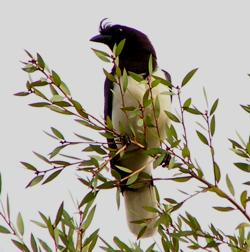
The curl-crested jay is a jay from South America.

Bradyrhizobium is a genus of Gram-negative soil bacteria, many of which fix nitrogen. Nitrogen fixation is an important part of the nitrogen cycle. Plants cannot use atmospheric nitrogen (N2); they must use nitrogen compounds such as nitrates.

Inga edulis, known as ice-cream bean, ice-cream-bean, joaquiniquil, cuaniquil, guama or guaba, is a fruit native to South America. It is in the mimosoid tribe of the legume family Fabaceae. It is widely grown, especially by Indigenous Amazonians, for shade, food, timber, medicine, and production of the alcoholic beverage cachiri. It is popular in Peru, Ecuador, Pernambuco-Brazil, Venezuela and Colombia. The taxonomic name Inga is derived from its name with the Tupí people of South America, while the species name edulis is Latin for "edible". The common name "ice-cream bean" alludes to the sweet flavor and smooth texture of the pulp.
Bradyrhizobium liaoningense is a species of legume-root nodulating, microsymbiotic nitrogen-fixing bacterium. It was first isolated from Glycine soja and Glycine max root nodules in China. Its type strain is strain 2281.
Bradyrhizobium canariense is a species of legume-root nodulating, endosymbiont nitrogen-fixing bacterium. It is acid-tolerant and nodulates endemic genistoid legumes from the Canary Islands. The type strain is BTA-1T.
Bradyrhizobium yuanmingense is a species of legume-root nodulating, endosymbiont nitrogen-fixing bacterium, associated with Lespedeza and Vigna species. Its type strain is CCBAU 10071(T).
Bradyrhizobium daqingense is a bacterium from the genus Bradyrhizobium.
Bradyrhizobium ganzhouense is a bacterium from the genus of Bradyrhizobium which was isolated from Acacia melanoxylon.
Bradyrhizobium jicamae is a Gram-negative, strictly aerobic bacteria from the genus Bradyrhizobium.
Bradyrhizobium pachyrhizi is a bacterium from the genus of Bradyrhizobium which was isolated from nodules of Pachyrhizus erosus in Guanacaste in Costa Rica.
Bradyrhizobium rifense is a bacterium that was isolated from nodules of Cytisus villosus from the Moroccan Rif.
Bradyrhizobium erythrophlei is a bacterium from the genus of Bradyrhizobium which has been isolated from the nodules of the tree Erythrophleum fordii.
Bradyrhizobium ferriligni is a bacterium from the genus of Bradyrhizobium which has been isolated from the nodules of the tree Erythrophleum fordii.
Bradyrhizobium manausense is a bacterium from the genus of Bradyrhizobium which has been isolated from the nodules from the plant Vigna unguiculata from the Amazon rainforest.
Bradyrhizobium neotropicale is a bacterium from the genus of Bradyrhizobium which has been isolated from the nodules of the tree Centrolobium paraense from the Amazon rainforest in Brazil.
Bradyrhizobium ottawaense is a nitrogen fixing bacterium from the genus of Bradyrhizobium which has been isolated from the nodules of soybeans in Ottawa in Canada.
Bradyrhizobium guangdongense is a bacterium from the genus of Bradyrhizobium which has been isolated from the effective nodules of a peanut plant.
Bradyrhizobium kavangense is a nitrogen-fixing bacterium from the genus Bradyrhizobium which has been isolated from the nodules of the cowpea Vigna unguiculata in the Kavango region in Namibia.
Bradyrhizobium subterraneum is a nitrogen-fixing bacterium from the genus of Bradyrhizobium which has been isolated from the effective nodules of the peanut Arachis hypogaea.

